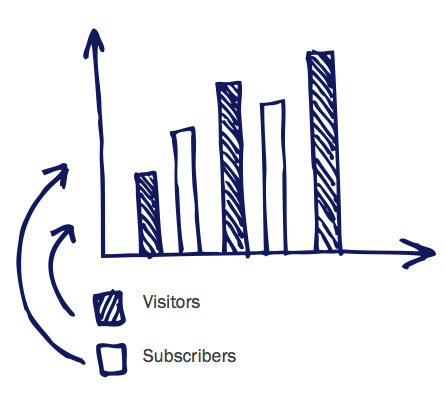More often than not, the difference between a 50-page website and a 500+ page site is a blog. Because of this, blogging is an essential practice for SEO and traffic building.
The biggest objection I typically hear when I bring up the idea of blogging is, “what am I supposed to write about?” The short answer: write about your keywords. Since you’ll be using your blog to write about your industry and niche, it will be a natural place to create content around the long-tail keywords you want to rank for.
In this post, we’ll walk through the steps of how to use a blog to grow your organic traffic.
1. Know your target audience.
I’m sure you’ve heard the phrase “you catch bees with honey.” That’s because bees like honey. Now, imagine trying to sell oranges to a customer on the hunt for apples. Could you probably sell them a few oranges? Yes. Would it be more difficult? Definitely. Understanding the needs of your customer puts you in a great place to make a sale or establish a relationship. If a customer is looking for apples, give them apples. Presenting them apple-based products like juices and pies wouldn’t be a stretch either.
Knowing your audience is key to creating content that they want. The first step is to establish your buyer persona. A buyer persona represents your ideal customer and will shape and guide your strategy as you dive deeper into the process. You can create a buyer persona from a combination of market research and examining data from existing customers. Essentially, you’re identifying your target audience and understanding their wants and needs to better attract them — like bees with honey.
Keep in mind that your target audience can change and will likely evolve over time. Make sure you periodically evaluate your target audience to better cater your content to them.
2. Identify keywords.
Let’s face it. Unless you’re Blogger, Wikipedia, or WordPress, you’re not going to take the top search engine result for the term “blog” anytime soon. And that’s okay. You can still get crafty and take a sizable chunk of traffic by thinking about how people search.
Most experienced Google users understand that using general terms isn’t going to get them where they want to go. Instead, people typically search for keyword phrases, for example, “how to use a blog.” If you were to use a keyword research tool to compare “blog” and “how to use a blog,” you’d find that the difficulty in ranking for the former is more than the latter.
To put it simply, this means that there is a better chance to rank for the keyword phrase “how to use a blog.” Note that your selected keyword might not have a high search volume, but if you can rank for a dozen or more long-tail keyword phrases related to the term “blog,” you’ll end up with a significant amount of traffic.
Long-tail keyword phrases help boost search engine rankings, but how do you identify which ones to use? Keyword research tools such as Google Keyword Planner, SEMRush, and Arel="noopener" target="_blank" hrefs Keywords Explorer are well-known tools among bloggers and marketers. These programs take a seed keyword, typically one or two words, and produce a list of relevant long-tail keywords. For example, a Google Keyword Planner search for “blog” provides keyword results that include “starting a blog,” “best blogging platform,” and “blog post ideas.”
When selecting which keywords to use, consider the following: search volume, keyword difficulty, and intent.
Search Volume
For a clear indication of how many people enter your keyword into a search engine, evaluate search volume. Often referred to as Monthly Search Volume (MSV), this metric can help you anticipate how much traffic is available; however, this information is not enough to predict the potential success for your keyword.
Keyword Difficulty
Keyword research tools such as HubSpot’s Keyword Grader tell you keyword difficulty — how hard it is to rank on the first page for a particular keyword search. The higher the assigned difficulty, the harder it is to rank in the search results. Evaluate keyword difficulty with search volume.
As of September 2021, Google’s Keyword Planner shows MSV results for “blog” and “how to use a blog” at 100K-1M searches for the former and 100-1K for the latter. Ahref’s Keyword Difficulty Checker assigns “blog” a keyword difficulty of 98 and “how to use a blog” a difficulty of 84. Both keywords are hard to rank for, but your best bet, as previously mentioned, would be “how to use a blog.” While the search volume for “blog” is significantly higher, the difficulty is equally high. Chances are you’d have a better opportunity of ranking with the long-tail keyword. Although the search volume is lower, the difficulty makes it easier to rank than “blog.”
Intent
Why are people searching for specific keywords? Understanding the reason behind a search helps you decide which keywords to use. With a search as vague as “blog,” it’s impossible to know the true intent behind it. One could assume that the person is looking for a definition or a blogging platform — at least that’s what Google assumes. The difference from “blog” to “how to use a blog” makes the intent behind the search more clear, and gives you a better chance at solving for that intent. The person searching is looking for a solution to a problem they’ve identified and will be more receptive to the information, resources, and tools made available to them.
3. Optimize your post around your keyword.
Once you have your target keyword, you need to optimize your post around it. Your keyword should appear in the following:
- SEO Title Tag
- URL
- Meta Description
- Article Title
- Subheadings
- Image Titles & Alt Text
- Body Content
SEO Title Tag
If and when your content appears on a search engine results page (SERPs), the SEO Title Tag is often the first thing noticed. The title tag appears as the name of the webpage and is clickable to the link destination. There is no limit to its length; however, Google only shows up to 70 characters in its SERPs. If your SEO title tag is longer than 70 characters, rearrange the wording to include the keyword in the beginning.
URL
The URL is not the most critical location for keywords, but it is one of the first places your keyword appears. It is another indicator to Google and your blog visitors of your content subject. Not only does the URL appear at the top of a webpage in the address bar, but it appears beneath the SEO Title Tag on SERPs.
Meta Description
Your selected keyword should appear in the meta description. Also featured on SERPs, the meta description is the text found beneath the URL. It combines using the keyword and enticing your readers with a description worthy of a click.
Article Title
The title of the page after readers click through to your content is the article title. Aim to use your keyword here as naturally as possible. If you’re still coming up with an awkward variation, rephrase your title while keeping as much of the keyword intact.
Subheadings
Before a reader commits to all of the content on a webpage, they’re going to skim through. Using subheadings makes it easier to digest information in a short amount of time. Include keywords in subheadings to help visitors evaluate how relevant your content is to them.
Image Titles & Alt Text
Don’t downplay the importance of optimizing images with keywords. Images are one way that people find your content. When saving images for your blog posts, use your keywords in the title. The second image-related place to use your keyword is in alt text. Alt text describes your image and is used to help make your content accessible for people with disabilities. Yes, your alt text should use your keyword, but it should be descriptive enough in case your image can’t be viewed.
Body Content
Keyword density is the number of times your keyword appears in the content and is often represented by a percentage. There is no target number for this. Instead, create your content with both your reader and keyword in mind. Afterward, revisit your content and see if you can naturally add your keyword without keyword stuffing. For a place to start, aim to include your keyword every 100-200 words.
4. Create new, quality content.
Ranking in search engines is all about competition. You might ask, “how do I rank higher,” but your real question is “how do I rank higher than others?” Appealing to your target audience and optimizing your post based on your keywords need to be done in conjunction with creating quality content to beat out your competition.
Hundreds, if not thousands, of ideas, are recycled on the internet today. The problem isn’t necessarily the idea but the execution. Writing content on “how to use a blog” isn’t a problem, but shaping it to look like every competing blog post is. Search engines prioritize fresh, quality content. Generate a few blog ideas and write something new. If the subject is not new, bring new ideas and perspectives to boost its quality.
5. Boost your content quality and credibility with links.
The proper use of links can boost your content in SERPs and your credibility as a resource. When creating content, pay attention to interlinks and backlinks.
Interlinks
When you create content, think of it as drawing a map. You direct your readers to where they should go next. Direct them with interlinks. Interlinking is when you link to other relevant articles on your site. The most significant benefit of this is keeping visitors on your website longer. It also boosts your content quality by providing readers with extra resources to round out their knowledge.
When setting up interlinks, pay attention to your anchor link text. It appears as clickable text highlighted as a link. Using identical text for a particular inbound link on your site could negatively affect your SEO. Vary your use of words and phrases when interlinking to the same webpage.
Backlinks
Backlinks boost credibility. A backlink is a link from one website to another, and the more backlinks you have, the more credible your website seems — to others and search engines. If your content links to another website, that company has a backlink from you. If another website links to your content, you have a backlink from them.
How do you prime your website for backlinks? Create linkable content. There will always be a need to link to quality content, and this can be a blog post, infographic, video, survey, or more.
6. Publish regularly.
Finally, publish your post. Depending on how frequently Google and other search engines scan your site, it could take a few days or longer for your pages to be indexed and appear in a Google search. A simple tip to get your pages into search engines faster is to publish more often. When Google notices that a site is getting updated daily, it will scan the site more regularly.
Ready to grow?
Blogs don’t experience organic growth overnight. One blog post isn’t going to make you a leader in your industry, but consistency will. The repeated application of the best practices listed above will strengthen your relationship with your target audience, boost your credibility as an online resource, and improve your site’s SEO — factors that will lead to increasing your blog’s organic traffic.
Editor's note: This post was originally published in May 2010 and has been updated for comprehensiveness.
Blog Optimization
.png?width=112&height=112&name=Image%20Hackathon%20%E2%80%93%20Horizontal%20(67).png)









![5 Ideas for Creating Killer Evergreen Content [+ Examples]](https://53.fs1.hubspotusercontent-na1.net/hubfs/53/Evergreen-content.jpg)

